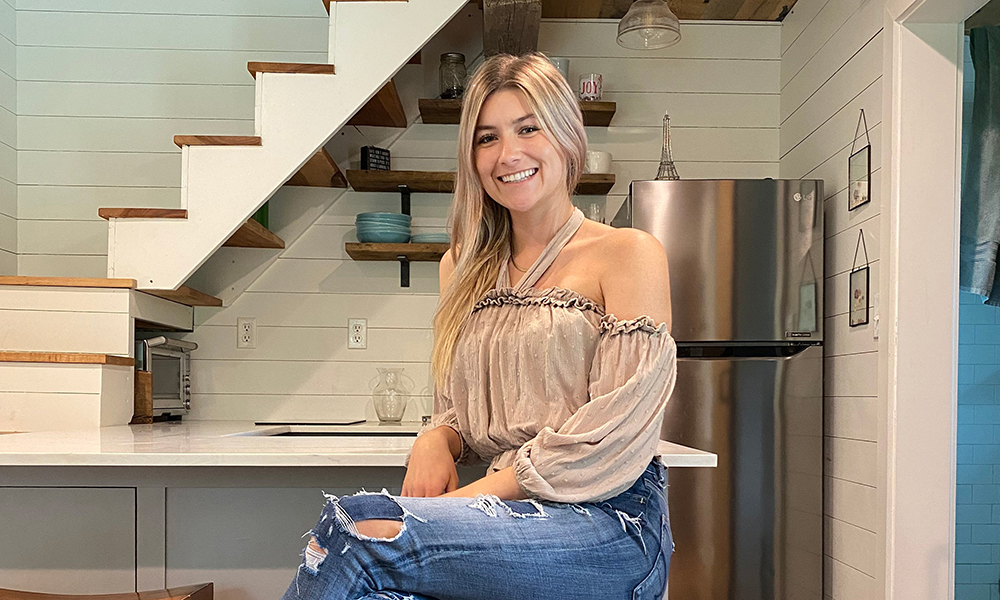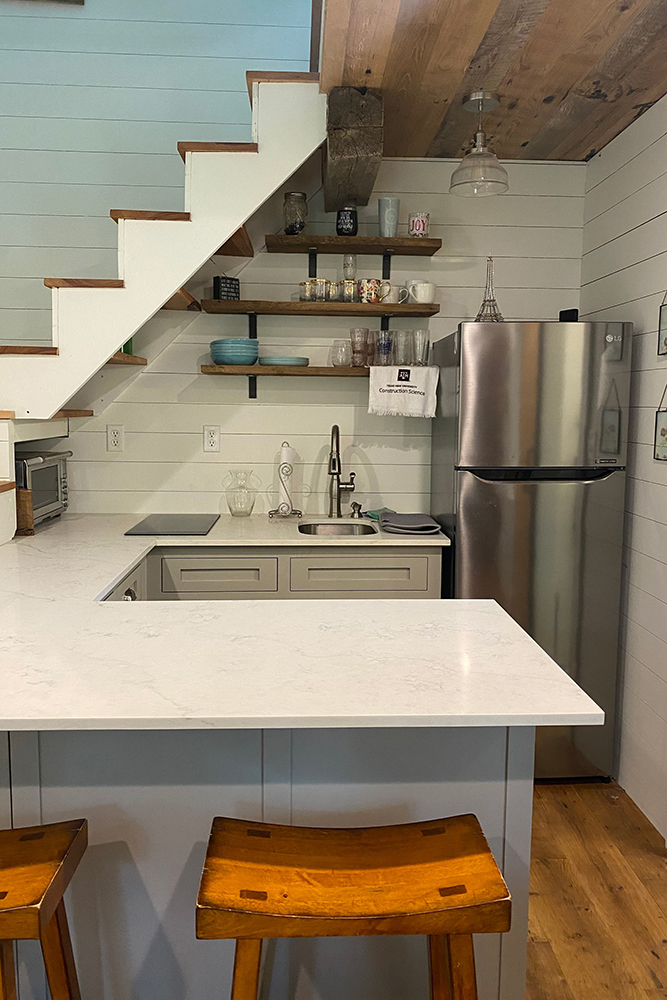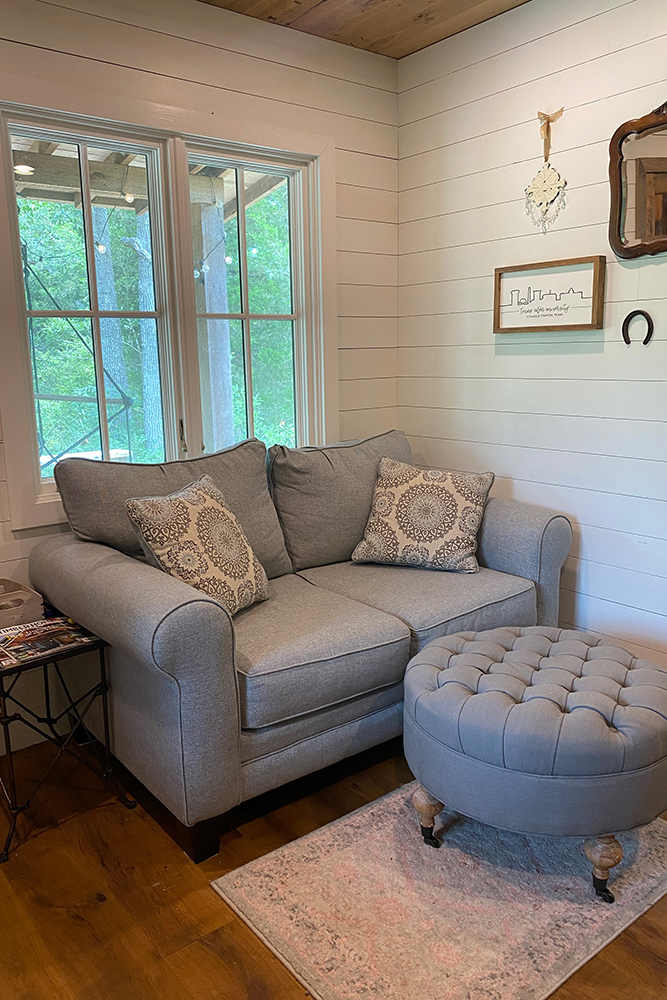
麥基恩·馬特森回憶稱,,她在五年級的時候,,想和朋友在父母位于美國得克薩斯州科利奇站的房子后院建一座堡壘。她們把她的秋千和滑梯推到一起,,這時她的父親走過來說:“為什么不真建一座堡壘呢,?”她從未想過,這座面積為350平方英尺(約32.52平方米)的堡壘后來會成為她生活了五年的家,,讓她推遲了進(jìn)入房地產(chǎn)市場的時間,。
馬特森大一的時候住在學(xué)校宿舍,,之后父母給她兩個選擇:租房自己住,,或者住在他們家后院的“小房子”里,只要她有需要,,而且可以免繳房租,。馬特森對《財(cái)富》雜志表示:“這個選擇就是,你能夠自己住,,但等你做好準(zhǔn)備的時候可以搬出去,。”回顧過去,,她說:“我絕對不會改變這個選擇,。”

之后的五年,,馬特森一直住在后院的堡壘里,,她在TikTok上發(fā)布與房地產(chǎn)和“蝸居”有關(guān)的內(nèi)容,擁有接近10萬粉絲,。她說粉絲給她發(fā)來大量征求意見的信息,,許多粉絲都是年輕人,在史無前例難以負(fù)擔(dān)的房地產(chǎn)市場中,,他們計(jì)劃攢錢買房,。有人甚至希望能夠獲得她的圖紙,計(jì)劃復(fù)制她的房子,。
馬特森節(jié)約的支出難以衡量,,但據(jù)Zillow統(tǒng)計(jì),在科利奇站,,所有臥室和物業(yè)類型的房屋平均租金為1,800美元,。她表示,她的朋友在共享公寓里的一間臥室,,每個月的租金約為800美元,,按五年來算相當(dāng)于48,000美元,。與馬特森的小屋大小類似的工作室,租金接近1,200美元,,這意味著她在五年內(nèi)可能節(jié)省了高達(dá)72,000美元,。馬特森說,她每天可以吃媽媽做的家常菜,,所以能夠節(jié)省餐費(fèi)支出,。
馬特森節(jié)省的支出不止這些。
她回憶稱,,她和父親用大約八個月時間,,將最初的堡壘改造成她的小家。除了大理石臺面以外,,他們自己動手完成了所有工作,。父母為她支付了從施工到裝修的所有費(fèi)用(她說房子面積很小,因此裝修費(fèi)用并不高),。馬特森表示,,她認(rèn)為建房成本不超過10萬美元。

在這套小房子的幫助下,,現(xiàn)在她可以購買自己的房子,。
馬特森表示,在成長過程中,,她經(jīng)??吹礁赣H自己動手打造各種物品。他擁有一家實(shí)木地板公司,,馬特森目前就在這家公司工作,,年收入約6萬美元。兩個月前,,她買下了一套三居雙衛(wèi)的房子,,距離父母家只有10分鐘車程。
馬特森說:“對單身的我而言,,這套房子已經(jīng)很寬敞,。”尤其是她曾經(jīng)居住的房子面積只有350平方英尺(約32.52平方米),,而現(xiàn)在的房子面積為1,500平方英尺(約139.35平方米),,有三間臥室和兩個衛(wèi)生間。馬特森表示,,這套新房售價(jià)25萬美元,,首付3%(約7,500美元)。按照30年固定利率6.87%計(jì)算,,她每個月的月供超過2,000美元,,她認(rèn)為這“太瘋狂了”,。據(jù)Zillow統(tǒng)計(jì),科利奇站的平均房價(jià)略高于325,600美元,,較去年上漲了6.4%,。
馬特森的經(jīng)歷并非特例。據(jù)皮尤研究中心(Pew Research Center)2022年的一份報(bào)告顯示,,過去五十年,,有越來越多的成年人搬到父母家中居住。新冠疫情爆發(fā)后,,2020年有超過一半29歲以下的美國人與父母生活在一起,,創(chuàng)下自大蕭條(Great Depression)以來的最高紀(jì)錄,而且大多數(shù)人表示他們與父母生活在一起的目的是為了省錢,。在新冠疫情期間的房地產(chǎn)熱潮(Pandemic Housing Boom)中,,全美房價(jià)上漲超過40%,而且個別市場的房價(jià)仍然在上漲,,高房價(jià)導(dǎo)致許多年輕人被擠出了房地產(chǎn)市場,,他們別無選擇,,只能與家人生活在一起,。
這些年輕人通常住在父母的房子里,但像馬特森這樣的做法正在變得日益普遍,。邁阿密大學(xué)(Miami University)的兩位建筑學(xué)教授大力提倡馬特森的住房類型,,又被稱為附屬住宅單元(ADU)。亨廷頓比奇市曾經(jīng)試圖禁止附屬住宅單元,,但在遭到加利福尼亞州起訴后,,這項(xiàng)禁令被廢除。
馬特森說:“如果我必須租房,,我就絕對不可能有能力買房,。我認(rèn)為再過五年到七年,我也無力購房,?!?/p>
馬特森還表示,如果在房價(jià)上漲的同時,,利率沒有從新冠疫情期間的低位大幅上漲,,情況可能就截然不同,因?yàn)樗⒉幌矚g剛剛買下的房子,,只是她認(rèn)為這是一筆很好的投資,。總之,,她表示如果沒有父母的扶持,,她就絕對不可能有今天的結(jié)果,。
馬特森說:“我的父母小時候生活并不富足,他們白手起家,,并出資建設(shè)了他們的房子,。他們不想我再經(jīng)歷這樣的事情,所以他們希望幫助我買房,?!?/p>
馬特森稱,她很享受與父親一起建造那棟小房子的過程,,包括挑選涂料顏色和在Pinterest上尋找靈感等,。馬特森表示,小房子的樓下有一張雙人沙發(fā),,工作臺面兩側(cè)各有一張吧臺椅,,還有一臺小冰箱。樓上是一張雙人床,,一個梳妝臺,,一個衣架,幾乎沒有儲物空間,。
當(dāng)然,,它之所以被稱為小房子,正是因?yàn)樗娣e很小,。在馬特森的一條TikTok視頻中可以看出,,一個大包裹就占據(jù)了整個臥室和廚房的空間。馬特森說,,如果她某一天沒有洗衣服,,這意味著她的房子里就沒有了下腳的地方,也無法做任何事情,??傮w上而言,她表示住在父母家后院“沒有什么大不了的”,,只是在這么小的房子里很難舉行閨蜜聚會,。

目前她正在搬家,她選擇為新房購買二手家具來減少開支,。她指出,,蝸居的經(jīng)歷讓她并不了解家具有多昂貴。雖然生活成本提高,,但她表示她很高興自己邁出了這一步,。
馬特森說:“我感覺,在24歲的年齡,在某個時刻我需要搬出父母的后院,?!彼硎荆嬖V父母未來她會重新回到家庭大院居住,,雖然她不再像以前那樣靠近父母,,但至少有家人在她身邊,馬特森非常喜歡這樣的氛圍,。
至于她的小房子,?它很快將迎來新租戶:她22歲的弟弟夫妻二人。(財(cái)富中文網(wǎng))
譯者:劉進(jìn)龍
審校:汪皓
麥基恩·馬特森回憶稱,,她在五年級的時候,,想和朋友在父母位于美國得克薩斯州科利奇站的房子后院建一座堡壘。她們把她的秋千和滑梯推到一起,,這時她的父親走過來說:“為什么不真建一座堡壘呢,?”她從未想過,這座面積為350平方英尺(約32.52平方米)的堡壘后來會成為她生活了五年的家,,讓她推遲了進(jìn)入房地產(chǎn)市場的時間,。
馬特森大一的時候住在學(xué)校宿舍,之后父母給她兩個選擇:租房自己住,,或者住在他們家后院的“小房子”里,,只要她有需要,而且可以免繳房租,。馬特森對《財(cái)富》雜志表示:“這個選擇就是,,你能夠自己住,但等你做好準(zhǔn)備的時候可以搬出去,。”回顧過去,,她說:“我絕對不會改變這個選擇,。”
之后的五年,,馬特森一直住在后院的堡壘里,,她在TikTok上發(fā)布與房地產(chǎn)和“蝸居”有關(guān)的內(nèi)容,擁有接近10萬粉絲,。她說粉絲給她發(fā)來大量征求意見的信息,,許多粉絲都是年輕人,在史無前例難以負(fù)擔(dān)的房地產(chǎn)市場中,,他們計(jì)劃攢錢買房,。有人甚至希望能夠獲得她的圖紙,計(jì)劃復(fù)制她的房子。
馬特森節(jié)約的支出難以衡量,,但據(jù)Zillow統(tǒng)計(jì),,在科利奇站,所有臥室和物業(yè)類型的房屋平均租金為1,800美元,。她表示,,她的朋友在共享公寓里的一間臥室,每個月的租金約為800美元,,按五年來算相當(dāng)于48,000美元,。與馬特森的小屋大小類似的工作室,租金接近1,200美元,,這意味著她在五年內(nèi)可能節(jié)省了高達(dá)72,000美元,。馬特森說,她每天可以吃媽媽做的家常菜,,所以能夠節(jié)省餐費(fèi)支出,。
馬特森節(jié)省的支出不止這些。
她回憶稱,,她和父親用大約八個月時間,,將最初的堡壘改造成她的小家。除了大理石臺面以外,,他們自己動手完成了所有工作,。父母為她支付了從施工到裝修的所有費(fèi)用(她說房子面積很小,因此裝修費(fèi)用并不高),。馬特森表示,,她認(rèn)為建房成本不超過10萬美元。
在這套小房子的幫助下,,現(xiàn)在她可以購買自己的房子,。
馬特森表示,在成長過程中,,她經(jīng)??吹礁赣H自己動手打造各種物品。他擁有一家實(shí)木地板公司,,馬特森目前就在這家公司工作,,年收入約6萬美元。兩個月前,,她買下了一套三居雙衛(wèi)的房子,,距離父母家只有10分鐘車程。
馬特森說:“對單身的我而言,,這套房子已經(jīng)很寬敞,?!庇绕涫撬?jīng)居住的房子面積只有350平方英尺(約32.52平方米),而現(xiàn)在的房子面積為1,500平方英尺(約139.35平方米),,有三間臥室和兩個衛(wèi)生間,。馬特森表示,這套新房售價(jià)25萬美元,,首付3%(約7,500美元),。按照30年固定利率6.87%計(jì)算,她每個月的月供超過2,000美元,,她認(rèn)為這“太瘋狂了”,。據(jù)Zillow統(tǒng)計(jì),科利奇站的平均房價(jià)略高于325,600美元,,較去年上漲了6.4%,。
馬特森的經(jīng)歷并非特例。據(jù)皮尤研究中心(Pew Research Center)2022年的一份報(bào)告顯示,,過去五十年,,有越來越多的成年人搬到父母家中居住。新冠疫情爆發(fā)后,,2020年有超過一半29歲以下的美國人與父母生活在一起,,創(chuàng)下自大蕭條(Great Depression)以來的最高紀(jì)錄,而且大多數(shù)人表示他們與父母生活在一起的目的是為了省錢,。在新冠疫情期間的房地產(chǎn)熱潮(Pandemic Housing Boom)中,,全美房價(jià)上漲超過40%,而且個別市場的房價(jià)仍然在上漲,,高房價(jià)導(dǎo)致許多年輕人被擠出了房地產(chǎn)市場,,他們別無選擇,只能與家人生活在一起,。
這些年輕人通常住在父母的房子里,,但像馬特森這樣的做法正在變得日益普遍。邁阿密大學(xué)(Miami University)的兩位建筑學(xué)教授大力提倡馬特森的住房類型,,又被稱為附屬住宅單元(ADU),。亨廷頓比奇市曾經(jīng)試圖禁止附屬住宅單元,但在遭到加利福尼亞州起訴后,,這項(xiàng)禁令被廢除。
馬特森說:“如果我必須租房,,我就絕對不可能有能力買房,。我認(rèn)為再過五年到七年,我也無力購房,?!?/p>
馬特森還表示,如果在房價(jià)上漲的同時,利率沒有從新冠疫情期間的低位大幅上漲,,情況可能就截然不同,,因?yàn)樗⒉幌矚g剛剛買下的房子,只是她認(rèn)為這是一筆很好的投資,??傊硎救绻麤]有父母的扶持,,她就絕對不可能有今天的結(jié)果,。
馬特森說:“我的父母小時候生活并不富足,他們白手起家,,并出資建設(shè)了他們的房子,。他們不想我再經(jīng)歷這樣的事情,所以他們希望幫助我買房,?!?/p>
馬特森稱,她很享受與父親一起建造那棟小房子的過程,,包括挑選涂料顏色和在Pinterest上尋找靈感等,。馬特森表示,小房子的樓下有一張雙人沙發(fā),,工作臺面兩側(cè)各有一張吧臺椅,,還有一臺小冰箱。樓上是一張雙人床,,一個梳妝臺,,一個衣架,幾乎沒有儲物空間,。
當(dāng)然,,它之所以被稱為小房子,正是因?yàn)樗娣e很小,。在馬特森的一條TikTok視頻中可以看出,,一個大包裹就占據(jù)了整個臥室和廚房的空間。馬特森說,,如果她某一天沒有洗衣服,,這意味著她的房子里就沒有了下腳的地方,也無法做任何事情,??傮w上而言,她表示住在父母家后院“沒有什么大不了的”,,只是在這么小的房子里很難舉行閨蜜聚會,。
目前她正在搬家,,她選擇為新房購買二手家具來減少開支。她指出,,蝸居的經(jīng)歷讓她并不了解家具有多昂貴,。雖然生活成本提高,但她表示她很高興自己邁出了這一步,。
馬特森說:“我感覺,,在24歲的年齡,在某個時刻我需要搬出父母的后院,?!彼硎荆嬖V父母未來她會重新回到家庭大院居住,,雖然她不再像以前那樣靠近父母,,但至少有家人在她身邊,馬特森非常喜歡這樣的氛圍,。
至于她的小房子,?它很快將迎來新租戶:她22歲的弟弟夫妻二人。(財(cái)富中文網(wǎng))
譯者:劉進(jìn)龍
審校:汪皓
In fifth grade, Mckean Matson recalls, she and a friend wanted to build a fort in the backyard of her parents’ house in College Station, Texas. They pushed together her swing set and slide, but then her dad walked over to them and said, “Why don’t we actually build a fort?” Little did she know that the 350-square-foot result would later become her home for five years, delaying her journey into the housing market.
After living in a dorm during her freshman year of college, Matson’s parents gave her two options: She could either rent a place of her own or live in the “tiny house” in their backyard rent-free for as long as she needed. “This was kind of like, you can be on your own, but when you’re ready, you can move,” Matson told Fortune. Looking back now, she says, “I would not have changed it for the world.”
For the next five years, Matson lived in the backyard fort and gained close to 100,000 followers on TikTok, where she posted housing and “tiny living” content. She says she gets tons of messages from her followers asking for advice, and a lot of them are young adults looking to save money in a historically unaffordable housing market. Some even requested blueprints to replicate her house for themselves.
It’s hard to put a number on how much Matson’s saved, but the average rent for all bedrooms and property types in College Station is $1,800, per Zillow. She says her friends typically pay around $800 a month for a bedroom in a shared apartment—that equates to $48,000 over a five-year timespan. A studio comparable to Matson’s tiny house would be closer to $1,200, meaning she could have saved as much as $72,000 over those five years. She also eats her mom’s home-cooked meals every day, Matson says, so she’s saved on food, too.
The savings go a bit further than that, too.
She recalls that it took her and her dad around eight months to turn the fort into her tiny home. They did everything themselves, except for the granite countertops. Her parents paid for everything, from the construction costs to furnishing (she says there wasn’t much to furnish because it’s so small). Matson said she thinks it cost them less than $100,000.
And now it’s helped her buy her own house.
Growing up, Matson said she always saw her dad build everything by hand. He owns a hardwood flooring company, and that’s where she currently works, making around $60,000 a year. Just two months ago, she closed on a three-bedroom, two bathroom house that’s 10 minutes away from her parents.
“It’s a lot for one person,” she says, especially given she was living in a 350 square-foot house, and now she’s living in a 1,500-square-foot, three bedroom, two bathroom house. Matson says she put down 3% (roughly $7,500) on her $250,000 new home. With a 30-year fixed rate at 6.87%, her monthly mortgage payment is over $2,000, which she says is “insane.” The average home value in College Station is slightly above $325,600, an increase of 6.4% over the past year, per Zillow.
Matson’s experience isn’t an anomaly—adults have been increasingly moving in with their parents for the past five decades, according to a 2022 report from Pew Research Center. Following the onset of the pandemic, 2020 was the first time since the Great Depression that over half of all Americans under 29 were living with their parents, and most said their motivation was to save money. With home prices rising more than 40% on a national level during the Pandemic Housing Boom, and still rising in some markets, many young adults are getting priced out and have no choice but to live with their family.
Those younger people who live with their parents typically live inside their parents’ home, but arrangements like Matson’s are becoming more common. Two professors of architecture at Miami University have advocated for Matson’s style of housing, also known as an accessory dwelling unit, or ADU. Although, the City of Huntington Beach attempted to ban ADUs but rescinded that ban after the State of California filed a lawsuit against the city.
“If I had to rent, there’s no way I would have been able to purchase a home,” Matson said. “I don’t think I would [have been] able to purchase for another five to seven years.”
If interest rates hadn’t shot up from their pandemic lows along with home prices, it might’ve been a different story, Matson added, given she doesn’t absolutely love the home she just bought but figured it was a good investment. Either way, she says she wouldn’t be where she’s at today without her parents’ help.
“My parents didn’t grow up with a whole lot of money, they started from nothing and paid cash for their whole entire house to be built,” Matson said. “They didn’t want me to ever have to go through that, and so they wanted to set me up.”
Matson says she loved everything about the process of building the tiny house with her dad, including choosing the paint colors and scrolling through Pinterest for inspiration. Downstairs, Matson says, there’s a loveseat, two barstools across from her countertop, and a narrow fridge that’s made for tiny houses. Upstairs, there’s a full bed, a dresser, a clothing rack, and pretty much no storage space.
But of course it’s called a tiny house for a reason—it’s small. In one of Matson’s TikTok videos, you can see that one large package takes up the whole living room and kitchen, while Matson says that not putting away her laundry for one day means not being able to walk anywhere or do anything. Overall, she said it was “no big deal” to live in her parents’ backyard, although she said throwing girls’ nights was pretty challenging in such a small house.
Now that she’s in the process of moving, she’s cutting back on her spending while shopping for used furniture to fill her new house—tiny living didn’t prepare her for how expensive furniture would be, she says. Despite life getting more expensive, she says she’s glad she took this step.
“I felt like, I’m 24 years old, at some point, I need to move out of my parents backyard,” Matson said. Still, she added that she’s told her parents she would return to live in a family compound one day, where she might not be as physically close to them as her previous situation but would be at least surrounded by family—which Matson really enjoys.
As for her tiny house? It’s getting a new tenant soon: Her 22-year old brother, along with his wife.






